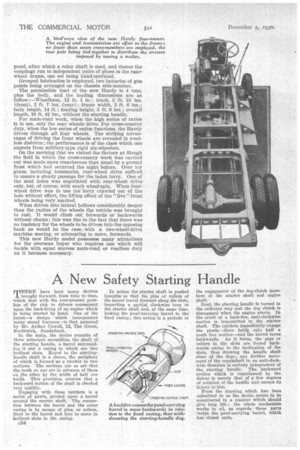A New Safety Starting Handle
Page 56

If you've noticed an error in this article please click here to report it so we can fix it.
rnHERE have been many devices ..I_ brought forward, from time to time, which deal with thc ever-present problem of the risk to drivers consequent upon the back-firing of an engine which is being started by hand. One of the latest—a design which incorporates many seund features—is that patented by Mr. Arthur Cowell, 12, The Green, Southwick, Sunderland.
In the main, the device consists of three principal assemblies, the shaft of the starting handle, a barrel surround,ing it and a casing in which are two inclined slots. Keyed to the startinghandle shaft is a sleeve, the periphery of which is formed us a ratchet in two sections. The sections are so set that the teeth on one are in advance of those on ,the other by the width of half one tooth. This provision ensures that a backward motion of the shaft is checked verY quickly.
Engaging with these ratchets is a series of pawls, pivoted upon a barrel around the starter shaft. The connection between the barrel and the outer casing is by means of pins, or rollers, fixed to the barrel and free to move in inclined slots in the casing.
c34
In action the starter shaft is pushed inwarlds so that the pins or rollers of the barrel travel forward along the slots, imparting a partial clockwise turn to the starter shaft and, at the same time, locking the pawl-carrying barrel to the fixed casing; this action is a prelude to
the engagement of the dog-clutch members of the starter shaft and engine shaft.
Next, the starting handle is turned in the ordinary way and the dog clutch is disengaged when the engine starts. In the event of a back-fire, anti-clockwise motion is transmitted to the starter shaft. The ratchets immediately engage the pawls—there beingonly half a tooth free motion—and the barrel turns backwards. As it turns, the pins or rollers in the slots are forced backwards owing to the inclination of the slots, thus drawing the handle shaft clear of the dogs; any further movement of the crankshaft in an anti-clockwise direction is entirely independent of tho starting handle. The backward motion which is experienced by the driver is merely that of a few degrees of rotation of the hartdle and cannot do injury to him.
From the drawing which has been submitted to us the device seems to be constructed in a manner which should give long life; the whole mechanism works in oil, as regards those parts inside the pawl-carrying barrel, which has closed ends.












































































































